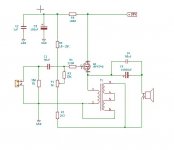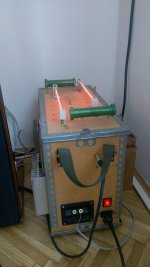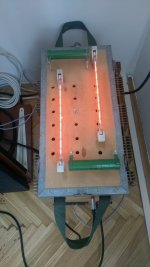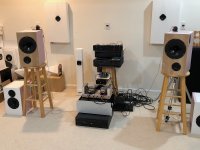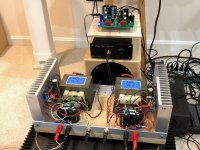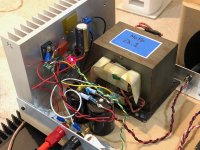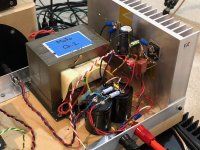As I need 1w I don't care about efficiency and max swing.
I build it and drive it directly from DAC 2vpp
No preamp. Volume is sufficient
Do i gain in sound quality if I move from bulb to inductor?
And going from 1A bias to 2A?
Have you built it yet or will build it? It’s not clear from how you describe it in present tense. If the volume is good enough and you are happy with the sound that’s all that matters. If driving a tweeter you don’t need much of an inductor, maybe 20mH tops. It will increase headroom, so for same swing the amp is not working as hard, and distortion goes down.
I build a prototype with 19v psu 0.8A bias and 1000w lamp. Volume was OK, sound still to evaluate.
For the compression tweeters starting at 600hz I plan to use 2.5mH air core is this enath?
For bass 1.6A 2000w bulb as I don't have any 50mH choke. In any case my swing can't go over the 2Vpp of the DAC as I don't use preamp
For the compression tweeters starting at 600hz I plan to use 2.5mH air core is this enath?
For bass 1.6A 2000w bulb as I don't have any 50mH choke. In any case my swing can't go over the 2Vpp of the DAC as I don't use preamp
While I've been waiting for the last of my MoFo components to arrive, I've been pondering the grounding requirements of this design.
I've noticed that most builds to this point (at least the ones with pictures) are mounting the heatsinks and chokes to non-conductive materials, usually wood.
I'm planning on zipping together a chassis frame with the mig welder from some 3/4" powder coated rectangular steel tube that I've got lying around. My heatsinks will mount directly to the sides of the frame and form the sides of the amp 'enclosure'. Solid sheet metal will be cut for the front and back, and the top and bottom will be sized from perforated sheet metal. I have all these materials already and need something stout like this to house the parts for a 4-channel MoFo using MOTs.
Planning on using sil-pads for the MOSFETs and clamping them to the heatsinks. What, if any, parts should I be concerned with insulating from one another? Going to use two SMPS units to provide DC, one for each channel pair, so grounding to any parts of a linear power supply is not a concern.
Do the chokes need to be isolated from my metal chassis? Anything else? I've read over the star and chassis grounding sections in 'Designing Audio Power Amplifiers' but most of the guidelines do not seem to apply to this design. If I need to isolate the chokes from the steel chassis, I think I've got some 1/2" micarta kicking around that I'll have to hunt for.
Thanks for any tips here.
I've noticed that most builds to this point (at least the ones with pictures) are mounting the heatsinks and chokes to non-conductive materials, usually wood.
I'm planning on zipping together a chassis frame with the mig welder from some 3/4" powder coated rectangular steel tube that I've got lying around. My heatsinks will mount directly to the sides of the frame and form the sides of the amp 'enclosure'. Solid sheet metal will be cut for the front and back, and the top and bottom will be sized from perforated sheet metal. I have all these materials already and need something stout like this to house the parts for a 4-channel MoFo using MOTs.
Planning on using sil-pads for the MOSFETs and clamping them to the heatsinks. What, if any, parts should I be concerned with insulating from one another? Going to use two SMPS units to provide DC, one for each channel pair, so grounding to any parts of a linear power supply is not a concern.
Do the chokes need to be isolated from my metal chassis? Anything else? I've read over the star and chassis grounding sections in 'Designing Audio Power Amplifiers' but most of the guidelines do not seem to apply to this design. If I need to isolate the chokes from the steel chassis, I think I've got some 1/2" micarta kicking around that I'll have to hunt for.
Thanks for any tips here.
Hi Briansz,
I think MOTs by design are grounded on the chassis from a microwave oven standpoint. The secondaries that make the HV (which we don’t use) have one end connected to the transformer steel plates. You can see this connection with a riveted copper wire loop on the side. Although mine mount on MDF mostly, the two rear mount points actually mount to the aluminum “frame” which is connected to the heatsinks. From a safety and noise standpoint, it’s oribably a good idea to have the MOT frames connected to earth GND. I use the heatsinks as the “Star” ground point on each amp. Right now I have not thought about should each channel be isolated GND from each other. They are connected via the aluminum angle brace that serves mount the heatsinks and jacks. Although the jacks are isolated, except the GND on the 5.5mm barrel power connectors are connected. So I may end up with a GND loop. If that happens I will see what needs to be done. One solution would be to electrically isolate heatsinks from aluminum angle brace.
I think MOTs by design are grounded on the chassis from a microwave oven standpoint. The secondaries that make the HV (which we don’t use) have one end connected to the transformer steel plates. You can see this connection with a riveted copper wire loop on the side. Although mine mount on MDF mostly, the two rear mount points actually mount to the aluminum “frame” which is connected to the heatsinks. From a safety and noise standpoint, it’s oribably a good idea to have the MOT frames connected to earth GND. I use the heatsinks as the “Star” ground point on each amp. Right now I have not thought about should each channel be isolated GND from each other. They are connected via the aluminum angle brace that serves mount the heatsinks and jacks. Although the jacks are isolated, except the GND on the 5.5mm barrel power connectors are connected. So I may end up with a GND loop. If that happens I will see what needs to be done. One solution would be to electrically isolate heatsinks from aluminum angle brace.
I was greatly inspired by Michael Rothacher’s MoFo. I like its simplicity and the fact that you can get almost the double voltage swing, dude to the inductor at the output, I also liked the fact that he was using laptop power supplies, wish makes the build much simpler.
Now I don’t have a pre amplifier that can drive it, since it requires a large input signal, so I had to think in alternatives. I did manage to redesign it to get some voltages of about 16 dB gain out of the circuit, with very small changes.
I build a mockup with the parts that I had in advance, just as a prove of concept and it dose work. Under the build I measured the transformers, and was surprised that the transformers that I had, works as a perfect inductor up to 12KHz (not bad for a 350VA 50Hz transformer). I only use the secondary side of the transformers; the primer side is well isolated to avoid electric chocks.
Now I am driving the amp’s on 15V, so the power is limited, but I don’t want to invest in new supplies until the amp’s has proven their worth. It is to early for me to comment on how they sound, I need to spend more time listen to them and they have to compete with my Single ended triode amp’s based on 845 tubes.
Anyway, I posted this in the hope to inspire people to experiment with this circuit, and make some measurements… I do not have the proper equipment to do so.
Happy new year to all
Now I don’t have a pre amplifier that can drive it, since it requires a large input signal, so I had to think in alternatives. I did manage to redesign it to get some voltages of about 16 dB gain out of the circuit, with very small changes.
I build a mockup with the parts that I had in advance, just as a prove of concept and it dose work. Under the build I measured the transformers, and was surprised that the transformers that I had, works as a perfect inductor up to 12KHz (not bad for a 350VA 50Hz transformer). I only use the secondary side of the transformers; the primer side is well isolated to avoid electric chocks.
Now I am driving the amp’s on 15V, so the power is limited, but I don’t want to invest in new supplies until the amp’s has proven their worth. It is to early for me to comment on how they sound, I need to spend more time listen to them and they have to compete with my Single ended triode amp’s based on 845 tubes.
Anyway, I posted this in the hope to inspire people to experiment with this circuit, and make some measurements… I do not have the proper equipment to do so.
Happy new year to all
Attachments
Last edited:
To add my 2 cents on MoFo: I have built a Mosfet Source Follower a few (maybe 10?) Years ago, I think it was Sewa amp, but i instead of a resistor I used a lightbulb, 220v, 1500 w halogen. Mosfet is Irfp 250N. 40v or 50 v supply I am not sure now. I was driving it with Bride of Zen preamp, which I later converted to something like Aleph L. Overall, it sounds nice and mellow with a "girl and a guitar" music but I was not quite happy with its bass, which lacked firmness. It always sounded "too mellow" so I quit using it. I was thinking of replacing the lightbulbs with Microwave oven transformers as chokes, but then I'd have to decrease the supply voltage...so...I just left it aside...
Attachments
MoFo in Main System with Aksa Lender Preamp
I finally finished the case work - always slow and tedious even if this is an "un-case" (no walls, just a baseplate). Both channels running at 1.7amps provided by a Juma's Easy Peasy cap multiplier which takes 24v from 5amp SMPS down to 19.5v and provides a soft-start for the 22mF//0.22R//22mF CRC before the amp. I am driving it with the Aksa Lender preamp at 22dB gain (can put out 40Vpp). Measured noise at speaker outputs is 0.1mV rms using Fluke 101. Ears pressed to the speaker cone, absolute silence. No hiss or hum. I did not do anything special with grounding and hoped for the best and luck was a lady tonight. The 2-way speakers are rather insensitive (true 82dB/2.83vrms at 50Hz) ScanSpeak 10F/8424 and Dayton RS225-8 FAST with transient perfect 1st order XO.
Here is the MoFo connected to my main speakers (the ones with the wood baffle on the stands) in the speaker lab:
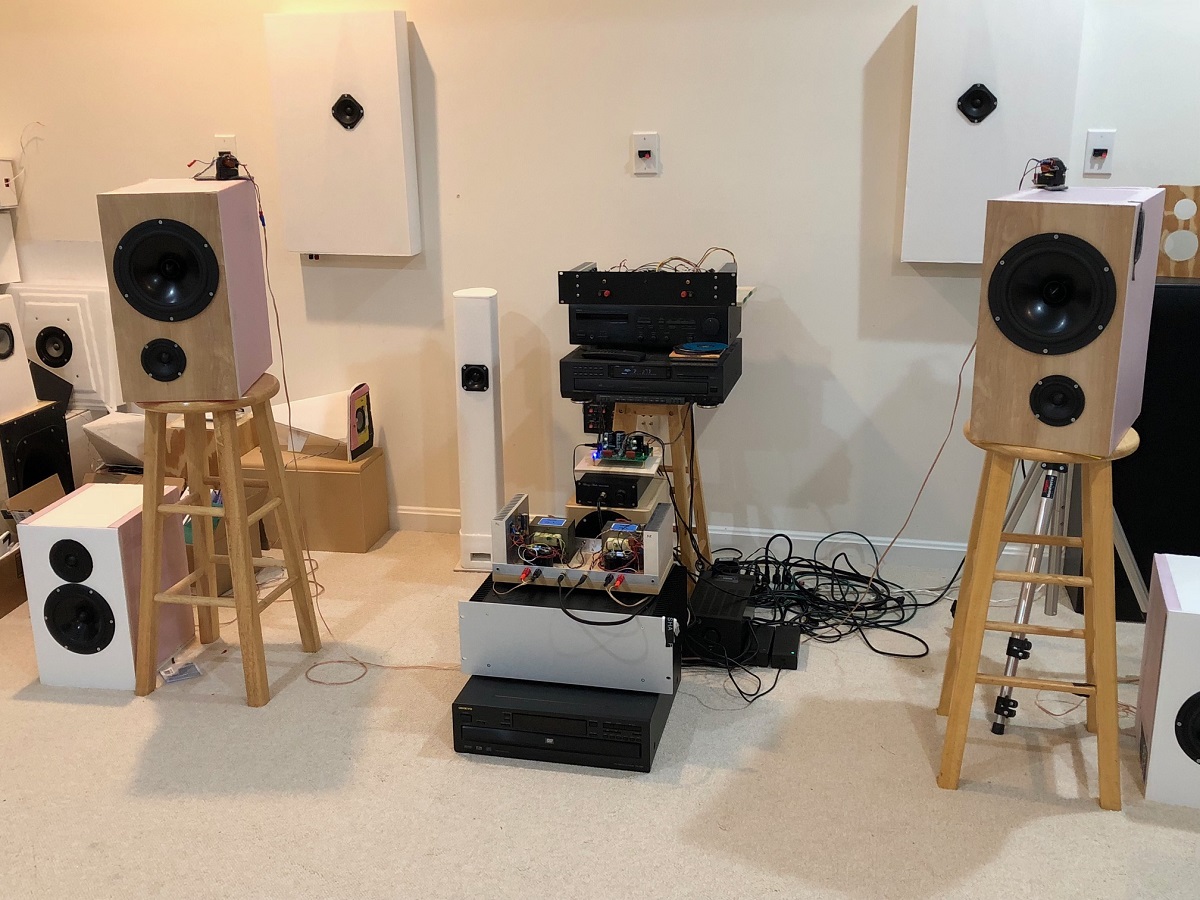
Here is a closer view of the MoFo sitting on top of the Aleph J's case, with the Aksa-Lender preamp behind it:
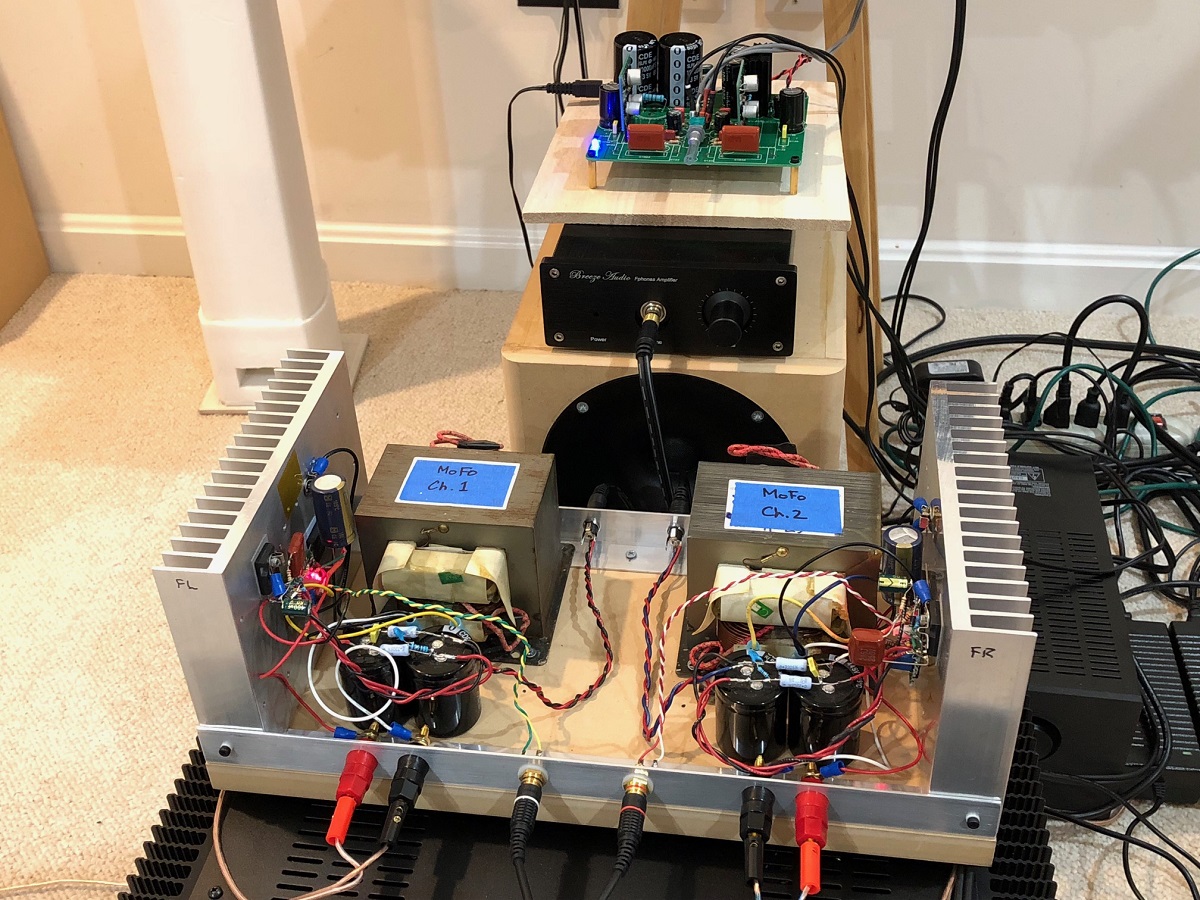
Closeup of left channel:
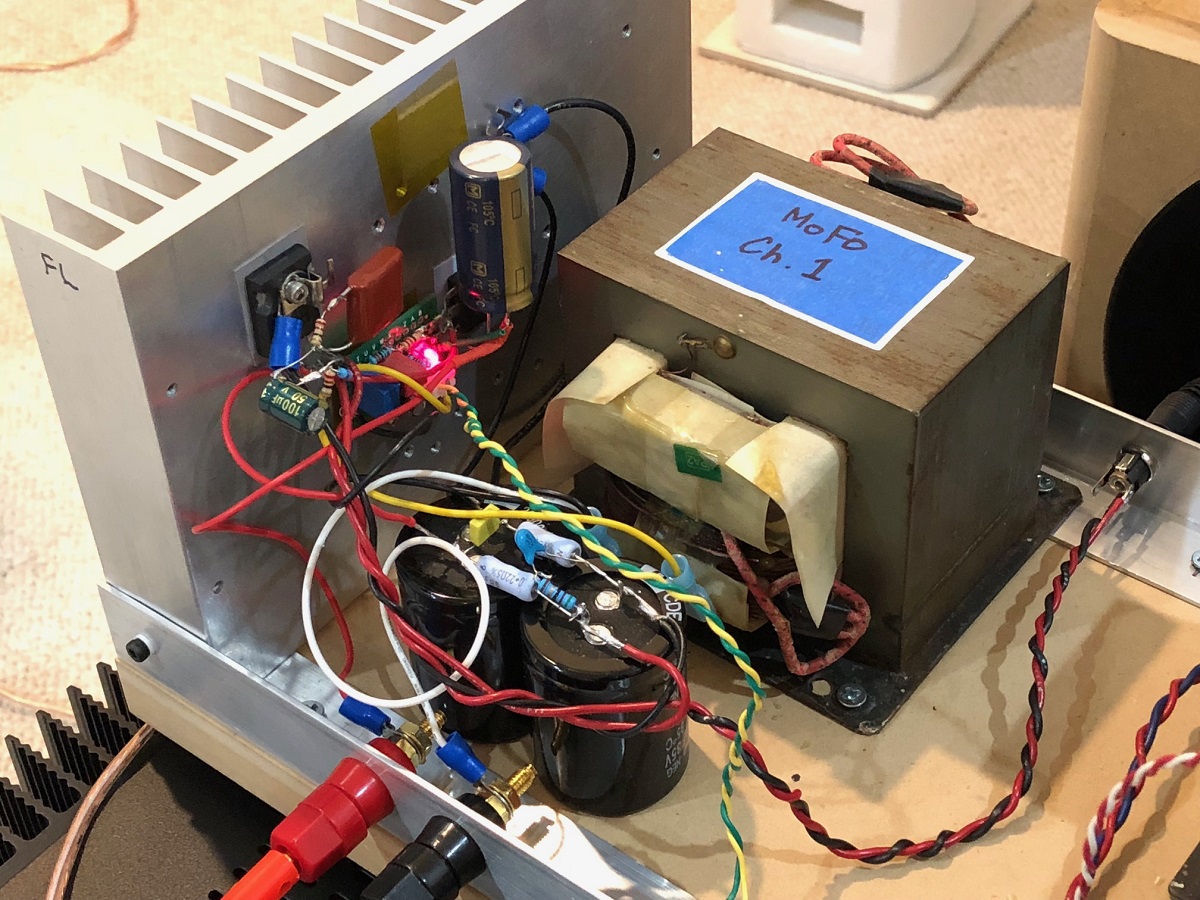
Closeup of right channel (at 1.7amp bias the heatsink temperature is exactly 55C):
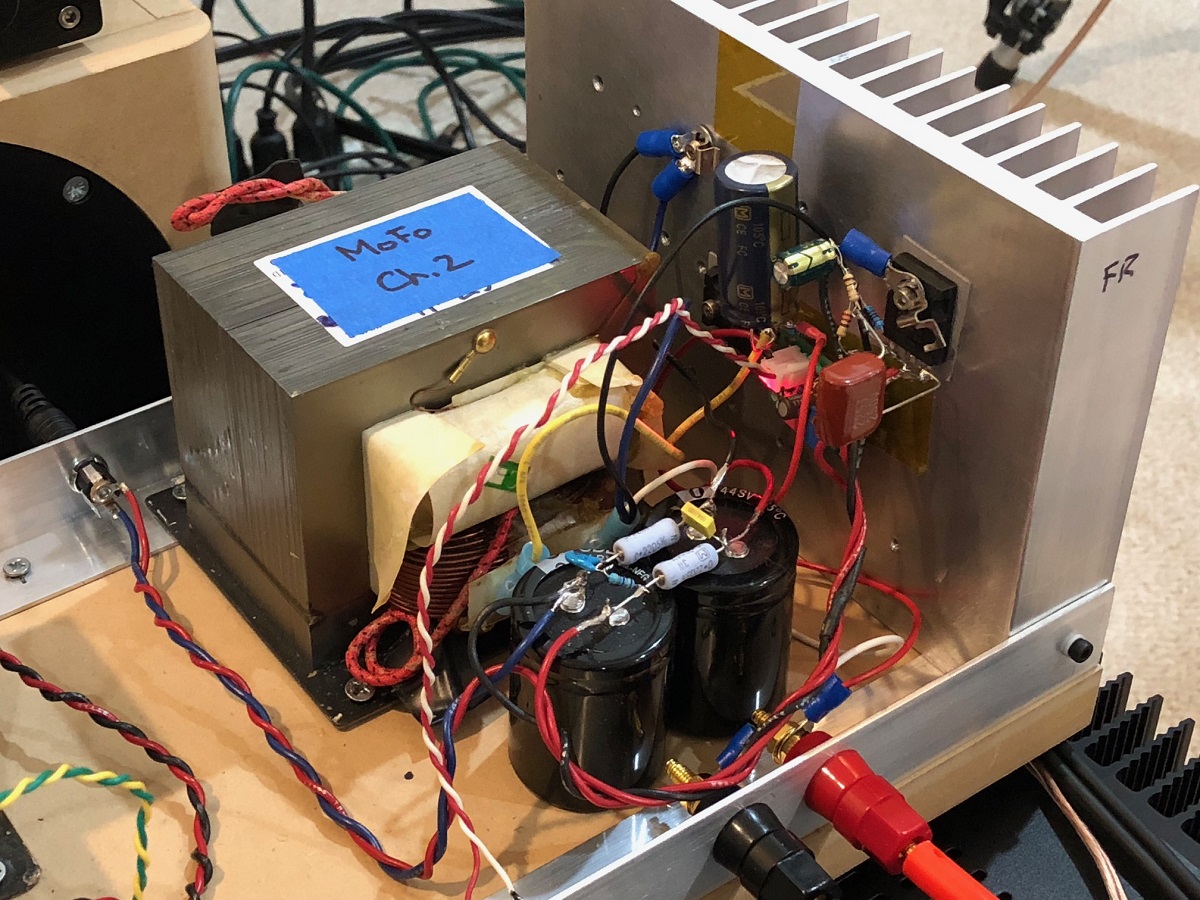
Well, how does it sound? Fantastic! Really surprised by the power I was able to get using the Aksa Lender preamp - the Fluke was measuring 8vrms on the loud passages and it sounded clean with nice articulation. Superb clear as a bell highs, and supple and smooth mids. The bass authority is really surprising the heck out of me. The 8in RS225-8 aluminum cone woofers are really dishing out the kick drums well. But what is special is that I have never connected a zero global feedback amp to these FAST speakers before. The phase coherence is incredible and the imaging and soundstage depth and width has never been better. On live ambient recordings, the realism is very very good. Transients like guitar, rimshots, clapping, bells all work well together with a transient perfect speaker and a zero global feedback amp. I am quite pleased how well this all worked out - the match with these speakers is excellent. Thanks to Hugh Dean's preamp design (which I had the MoFo in mind as the use case when designing and building), JPS64 for the preamp layout, and thanks to Michael Rothatcher for a superbly simple yet brilliant sounding amp. Bang for the buck is through the roof.
I finally finished the case work - always slow and tedious even if this is an "un-case" (no walls, just a baseplate). Both channels running at 1.7amps provided by a Juma's Easy Peasy cap multiplier which takes 24v from 5amp SMPS down to 19.5v and provides a soft-start for the 22mF//0.22R//22mF CRC before the amp. I am driving it with the Aksa Lender preamp at 22dB gain (can put out 40Vpp). Measured noise at speaker outputs is 0.1mV rms using Fluke 101. Ears pressed to the speaker cone, absolute silence. No hiss or hum. I did not do anything special with grounding and hoped for the best and luck was a lady tonight. The 2-way speakers are rather insensitive (true 82dB/2.83vrms at 50Hz) ScanSpeak 10F/8424 and Dayton RS225-8 FAST with transient perfect 1st order XO.
Here is the MoFo connected to my main speakers (the ones with the wood baffle on the stands) in the speaker lab:
Here is a closer view of the MoFo sitting on top of the Aleph J's case, with the Aksa-Lender preamp behind it:
Closeup of left channel:
Closeup of right channel (at 1.7amp bias the heatsink temperature is exactly 55C):
Well, how does it sound? Fantastic! Really surprised by the power I was able to get using the Aksa Lender preamp - the Fluke was measuring 8vrms on the loud passages and it sounded clean with nice articulation. Superb clear as a bell highs, and supple and smooth mids. The bass authority is really surprising the heck out of me. The 8in RS225-8 aluminum cone woofers are really dishing out the kick drums well. But what is special is that I have never connected a zero global feedback amp to these FAST speakers before. The phase coherence is incredible and the imaging and soundstage depth and width has never been better. On live ambient recordings, the realism is very very good. Transients like guitar, rimshots, clapping, bells all work well together with a transient perfect speaker and a zero global feedback amp. I am quite pleased how well this all worked out - the match with these speakers is excellent. Thanks to Hugh Dean's preamp design (which I had the MoFo in mind as the use case when designing and building), JPS64 for the preamp layout, and thanks to Michael Rothatcher for a superbly simple yet brilliant sounding amp. Bang for the buck is through the roof.
Attachments
Last edited:
Hi Briansz,
I think MOTs by design are grounded on the chassis from a microwave oven standpoint. The secondaries that make the HV (which we don’t use) have one end connected to the transformer steel plates. You can see this connection with a riveted copper wire loop on the side. Although mine mount on MDF mostly, the two rear mount points actually mount to the aluminum “frame” which is connected to the heatsinks. From a safety and noise standpoint, it’s oribably a good idea to have the MOT frames connected to earth GND. I use the heatsinks as the “Star” ground point on each amp. Right now I have not thought about should each channel be isolated GND from each other. They are connected via the aluminum angle brace that serves mount the heatsinks and jacks. Although the jacks are isolated, except the GND on the 5.5mm barrel power connectors are connected. So I may end up with a GND loop. If that happens I will see what needs to be done. One solution would be to electrically isolate heatsinks from aluminum angle brace.
Thanks for your comments, I will hold off on cutting my front/back/top/bottom pieces until I see if it becomes necessary to isolate the heatsinks from the metal amp chassis, will be no problem to earth GND the MOT frames.
Congratulations, X!! Beautiful setup, very nice built and implemented, your work is outstanding in every way.
I remember building the Pass Zen many, many years ago. It started me out on the Zero Global Feedback path, these is no doubt these power amps are best with no GFB. Preamps can use it because they are Class A, small, and very fast, but power amps cannot.
Love the way you double your power output with inductors, and source them innovatively, costing almost nothing!
I wish I were listening to it now.......
Ciao,
Hugh
I remember building the Pass Zen many, many years ago. It started me out on the Zero Global Feedback path, these is no doubt these power amps are best with no GFB. Preamps can use it because they are Class A, small, and very fast, but power amps cannot.
Love the way you double your power output with inductors, and source them innovatively, costing almost nothing!
I wish I were listening to it now.......
Ciao,
Hugh
The IRFP150 is 2800pF Input capacitance, whereas the 240 is 1300pF. You may be better off with parallel 240’s.
If I had bigger heatsinks I would try dual IRFP240’s with 48V Vcc and the same MOT and 2.8amps bias. Now that would be impressive power output.
Maybe water-cooling would be a good option here.
If I had bigger heatsinks I would try dual IRFP240’s with 48V Vcc and the same MOT and 2.8amps bias. Now that would be impressive power output.
Maybe water-cooling would be a good option here.
Herr Muller's business is not so critical when source follower is in the case , even if load is choke (AC voltage potential difference between gate and source almost double comparing with resistive loading)
240 is good there .... in fact anywhere if you are up to 35(40)W of heat per piece
240 is good there .... in fact anywhere if you are up to 35(40)W of heat per piece
- Home
- Amplifiers
- Pass Labs
- Build This MoFo!
